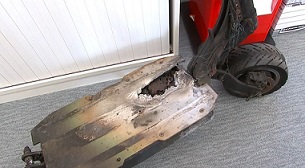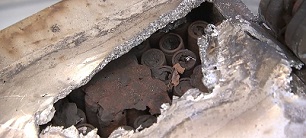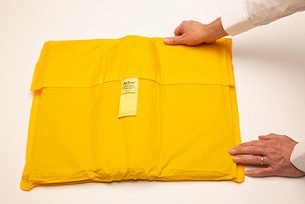 An e-scooter damaged by a lithium battery fire
An e-scooter damaged by a lithium battery fire
 Lithium fire safety. Tony Walker from North Yorkshire Fire and Rescue Service.
Lithium fire safety. Tony Walker from North Yorkshire Fire and Rescue Service.
 Close-up of an e-scooter after a lithium battery fire
Close-up of an e-scooter after a lithium battery fire
 An AvSax lithium battery fire mitigation bag
An AvSax lithium battery fire mitigation bag
Cheap chargers for battery powered scooters and bikes are putting lives at risk … and people are making the danger even worse by charging them in communal spaces and at night.
ITV News has just done a report revealing that the number of fires caused by lithium batteries has more than double in the UK over the last year.
But they also reveal how people who charge lithium batteries for their scooters or bikes are putting themselves and others needlessly in danger.
If they do it at night they will be slow to react. The batteries catch fire with incredible intensity, will fill a room with heat and flames in seconds and often explode.
People could be overcome by the toxic smoke within seconds.
The other main danger is that people living in multi-occupancy flats charge them in halls and corridors – often the only means of escape for them and others should the battery catch fire.
London firefighters dealt with more than 70 fires involving e-scooters and e-bikes in 2021 and the same year Transport For London banned e-scooters from London’s transport network due to the number of fires happening on buses and in the underground. The fire toll went up to 88 in 2022 in London.
In the USA the situation is even worse with lithium batteries on e-scooters or e-bikes sparking 22 fires in New York so far in 2023 causing 36 injuries and two deaths. In 2002 there were 200 such fires in New York leading to six deaths.
Tony Walker from North Yorkshire Fire and Rescue said: “If you’re charging lithium batteries in common areas like a landing we would like you to stop this practice immediately because these common areas are people’s means of escape.”
Product safety engineer Giuseppe Capanna told ITV: “Don’t charge them overnight because if something happens and something goes wrong then your reactions are going to be delayed so the results are going to be much worse.
“Don’t charge them in escape routes because they might compromise your way out of the building.”
The Chartered Trading Standards Institute says the number of fires caused by lithium batteries has increased by almost 150% over the last year.
Christine Heemskerk from the Institute said: “It’s really concerning because our remit is to ensure that only safe products get onto the market.
“I think there is an increased demand in e-scooters and e-bikes now and manufacturers in the Far East are struggling to meet that demand and are probably cutting corners. They are trying to put a cheap product on the market rather than a safe product.”
The danger of lithium battery fires is a real risk on aircraft which is why many aircraft are equipped with thermal lithium battery fire containment bags.
The world’s best-selling lithium battery fire mitigation bag is the British designed AvSax now on board around 16,750 aircraft operated by more than 100 airline companies. AvSax have been deployed in action 33 times on board aircraft since 2017 and on every occasion the aircraft was able to continue safely to its destination with no need to divert or make an emergency landing.
The company behind AvSax, Yorkshire-based Environmental Defence Systems Ltd, is now looking at ways to use its technology to mitigate the risk of e-scooter and e-bike battery fires.
Top tips on preventing lithium battery fires